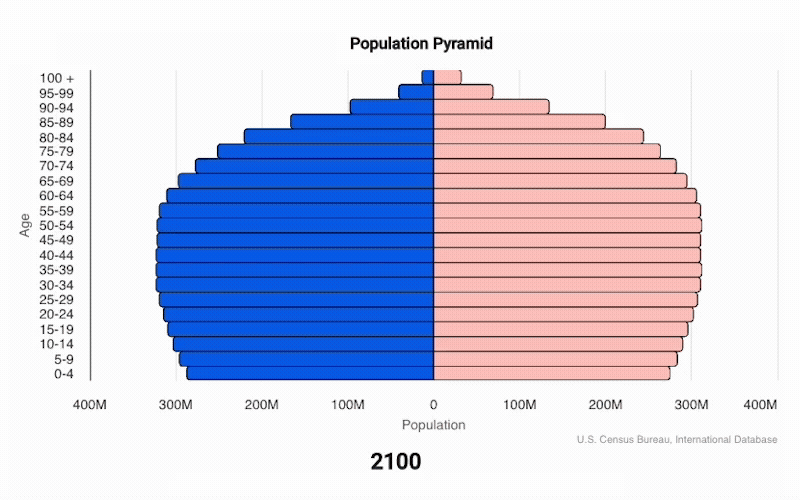“Demography is destiny.”
While executives grapple with AI’s uncertain timeline, climate change’s unpredictable impacts, and the chaotic swings of geopolitics, one megatrend operates with mathematical precision: demographics. Unlike every other force reshaping our future, a nation’s population does not deal in probabilities — it deals in certainties already locked into census data.
There are several reasons why we chose demographics for the first topic in our nowcasting series. For one thing, we’ve been obsessed with demographics for a while; we wrote extensively about the aging of America in 2019, and presented at Harvard Business School on how shifting demographics will change how we define growth and prosperity.
While the global population is still growing, many countries are experiencing slow or even negative population growth. Following half a century of fears about overpopulation, we’re now approaching an entirely different milestone: Global population is projected to peak in the 2080s at 10.3 billion before beginning its first-ever recorded decline. Japan provides a stark example of our global future, having experienced negative population growth for 14 consecutive years.
As French philosopher Auguste Comte posited in the 1800s, demography — the size and structure of a population — is destiny. Demographic shifts can feel overwhelming due to the outsized impact they have on a nation. Population structure reverberates through consumer demand, labor markets, tax bases, innovation capacity, and political priorities. This interconnectedness challenges our basic assumptions –– and presents an opportunity to reimagine how our economies, societies, and governments operate.
What’s true right now
Population structure is the result of four factors: longevity (how long people live), fertility (how many children they have), cohort size (how many people are in each age group), and immigration patterns (how they move from place to place). In our modern era, these factors are largely dictated by the choices a society or nation makes.
Investments in public health, medical advances, road safety, and relative economic prosperity have extended longevity. Global life expectancy increased from 46 years in 1950 to 71 years in 2021. South Korea stands out among industrialized nations, having increased life expectancy by 31 years over the past six decades; South Korean women will soon have the longest life expectancy in the world. African nations have also made significant gains by reducing child mortality and tackling infectious diseases.
At the same time, fertility has plummeted due to a complex mix of preference and economics. In the second half of the 20th century, global population boomed, and overpopulation was a concern for many. At the same time, women gained access to education, employment, financial services, and reproductive rights — expanding opportunities for both families and communities.

This animated chart from the U.S. Census Bureau shows how age demographics are changing dramatically, resulting in a population distribution that will look more like a pillar than a pyramid in the coming decades.
Fast forward to the 21st century, and the downstream effects of these choices have reordered societal norms and demographic makeup. More people are single, increasingly by choice. People are also having fewer children, if any at all. While the cost of raising children matters — with families needing 40% more income to maintain their standard of living after having a first child — this is also often by choice: 57% of adults under 50 who say they’re unlikely to have children say they simply don’t want to be parents, with 44% preferring to focus on careers and other interests.
Cohort sizes amplify these trends: The fastest-growing demographic in the U.K. is people over 80. The massive Baby Boomer generation (people born 1946-1964) is entering retirement with longer lifespans, while the large Millennial cohort (people born 1981-1996) is having fewer children than previous generations at the same age. America’s median age hit a record 39.1 in 2024, and the U.S. is rapidly approaching a historic crossover where older adults (65+) will outnumber children under 18 by 2034. This shift is already reshaping America, where 11 states and nearly half of all counties now have more seniors than children; though this was once considered a rural trend, three major U.S. metro areas (Cleveland, Providence, and Hartford) crossed this threshold for the first time in 2024.
As demographics operate on a ~20-year lag, immigration remains the most obvious tool for more immediate population adjustment. While policies can influence longevity and fertility rates in the longer term, we can’t simply manufacture new adults. Spain is taking a pragmatic approach to immigration, resulting in an expanding economy despite having the second-lowest birthrate in Europe.
Globally, the paradox is striking: Countries with economies currently benefiting from more balanced population structures will likely face similar shifts toward aging populations in the coming decades. For example, Saudi Arabia’s relatively young population will likely translate into a sizable workforce. However, as fertility continues to drop and life expectancy increases, its population’s age structure will eventually look similar to that of Western nations.
Impacts and implications
The 2030s will mark one of the most dramatic demographic transformations in American history. The “Silver Tsunami” alarm has been ringing for decades; now it is well past time to build higher ground. Over the next decade, as Generation Beta (people born in 2025 and after) arrives, America will witness seven living generations coexisting for the first time ever, creating unprecedented complexity in workforce planning, healthcare demand, and intergenerational wealth transfer. The demographic math is unforgiving: We know roughly how many 70-year-olds will exist in 2035 because they’re already 60 today. This relative certainty creates both challenges and opportunities. While we can’t change the demographic momentum already set in motion, we can reimagine business strategy, social contracts, and policies to thrive during this transformation rather than simply endure its disruptions.
Economy
When demographics invert and there are more consumers than producers, the economic rulebook gets rewritten. Italy, Bulgaria, and Portugal already have fewer than three working-age people supporting every retiree. By mid-century, most major economies will have more dependents than workers — a complete inversion of the population structure that built the modern world.
Supply and demand teaches us that when there are fewer workers, wages increase, and theoretically, economies will be closer to full employment. While this seems positive for workers, the downstream effects create competing pressures. Labor supply constraints drive inflationary pressure by raising production costs. These same workers must simultaneously support aging family members while contributing to a shrinking tax base, creating an unclear path for funding an increasingly essential social safety net, including child care and elder care.
However, demographic inversion can also create deflationary forces. As aging populations reduce consumption of certain goods and services, this decreased aggregate demand pulls prices down in some sectors. Assets built over a lifetime, such as thriving small businesses that cannot find successors, may suddenly be worthless.
The net inflationary effect depends on whether aging stems from declining fertility (potentially inflationary due to a smaller tax base) or increased longevity (potentially deflationary as retirees prefer low inflation to protect savings). As American demographics are shaped by both longevity and a decrease in fertility, the U.S. is likely to experience simultaneous inflation in labor-intensive sectors like healthcare and construction, with deflation in more youth-oriented goods and services that no longer meet the needs of an aging population. Longer term, economists speculate that while aging populations are currently driving inflation through labor shortages and wage pressures, they may eventually become deflationary as savings patterns and reduced consumption take hold.
Economies built on growth assumptions face a fundamental challenge: how to maintain prosperity without an expanding population. Traditional metrics like GDP become misleading when wealth concentrates among fewer people in aging, shrinking populations. Countries experiencing population decline will need new models focused on productivity gains, technological leverage, and individual prosperity rather than population-driven expansion or aggregate growth.
- How will you achieve sustainability and prosperity when you can’t depend on traditional audiences or market growth in your core markets?
- Which markets become more attractive over the next 10-30 years, and how will you pivot before your current markets peak or decline?
- What products and services will become less valuable with an aging population, and what new offerings will see higher demand?
- How will changing dependency ratios affect tax policies and regulatory costs in your operating regions?
- Which assets or business lines should you divest before demographic headwinds intensify?
Societal norms and structures
Reimagining an older-majority society has myriad cultural implications. Unlike many Asian societies, America has historically prioritized youth and independence over reverence and care for elders. During the 20th century, the responsibility for elder care gradually shifted away from families and was instead supported by the introduction of Social Security, Medicare, and Medicaid. Now, in the 21st century, longer lifespans and caregiver shortages have created an unprecedented situation: Nearly 23 million working adults provide care to older adults, surpassing the 21 million who care for preschool children. For the first time in U.S. history, more Americans are caring for elders than for young children.
Housing is also a critical consideration: Is it better to retrofit existing structures for aging in place, or is it better to build with planned obsolescence, knowing future smaller generations may not need or want the same accommodations? Americans are increasingly trading in their nuclear-family living situations for multigenerational households –– with cost savings cited as the primary motivator.
Over the next 30 years, accessibility is likely to become the default rather than the exception. This might mean larger fonts on everything from road signs and websites to restaurant menus and medication labels, ramps and railings as standard architectural features, and lever-style door handles replacing traditional knobs. Universal design principles could govern new development — wider doorways in homes, curbless showers, motion-sensor lighting, and voice-activated technology becoming standard rather than special accommodations. Public spaces may feature more benches and rest areas, while transportation systems could prioritize step-free access and clear audio and visual announcements.
- How might you redesign your organization’s products or services to accommodate older consumers?
- What housing policies and zoning changes are needed when fewer people can afford separate housing and more families choose multigenerational living?
- If multiple generations are living in the same house instead of separate homes, how will that impact demand for utilities, internet, and consumer products and services?
- How will workplace policies and benefits change if more employees are caring for elders?
- What opportunities exist to rethink public spaces, retail environments, and service delivery for our changing demographics?
Government and policy
Aging societies face new political frictions: When the voting population skews dramatically older, consumers of government services increasingly dictate policy for the producers who fund them. The UK’s Brexit vote exemplified this generational divide, with 70% of 18-24 year-olds voting to remain in the European Union and 65% of those over 65 voting to leave. This is just one example of how aging electorates can impose irreversible decisions on younger generations who must live with the consequences longer.
It’s easy for most voters to imagine how government spending priorities and service delivery will need to adapt to shifting demographics. U.S. policymakers introduced Medicare and Social Security when America was a “young” nation. Now, countries must reimagine benefit programs for a world where fewer working-age people carry the burden for a larger population of aging beneficiaries. Increasing the retirement age or income level for benefits entitlement is almost always an unpopular policy move — which is why some administrations try to incentivize retirees to delay their benefits instead.
Declining birth rates also signal dramatic changes for education. Following decades of overcrowding, many U.S. states are facing a public school enrollment cliff. This may result in a decreased demand for public school infrastructure, with some schools consolidating or even closing. Private school economics may also shift as demand decreases, and schools may increasingly compete for students.
The U.S. policy innovation era of the 1960s and 1970s asked “What do children need to thrive?” and answered that question with programs like Head Start and WIC. Though long-range research has shown that early-childhood policy interventions yield positive outcomes and boost economic prosperity, few child-centered programs have been funded in more recent decades. With a smaller tax base to support education and youth programs, contemporary policy debates remain stubbornly adult-centric. Even ostensibly “pro-child” policies are primarily framed around adult convenience, workforce participation, and economic productivity. But expanding opportunities for society’s youngest generations is critical to ensuring continued collective growth and progress.
Historically, immigration has also increased prosperity in the United States, enabling economic growth, increasing the tax base, and spurring innovation and invention. Without thoughtful policies creating more legal pathways to residency and citizenship, there simply is no mathematical path to economic growth. The choice isn’t ideological — it’s existential: Aging nations will need to embrace and incentivize immigration and other smart policies if they want to mitigate otherwise inevitable declines in population and prosperity.
- How will monetary policy adapt when demographic shifts fundamentally alter inflation dynamics — with potential deflationary pressure from shrinking demand but inflationary pressure from labor shortages?
- How will we collectively ensure that future generations are equipped to drive innovation (and not just bear burdens)?
- How will workplaces change if more older employees delay retirement?
- How should Social Security, Medicare, and pension systems adapt when traditional retirement ages become obsolete?
- How might nations reimagine immigration policies to offset demographic decline while creating opportunities for everyone to thrive?
If you have burning questions about our present moment, or if you’d like to chat with us about how to use nowcasting as part of your own organization’s planning and strategy, we’d love to hear from you: Email nowcasting@luminary-labs.com to connect with us.
Receive insights and updates — including our nowcasting series — in your inbox: Subscribe to the Lab Report.


